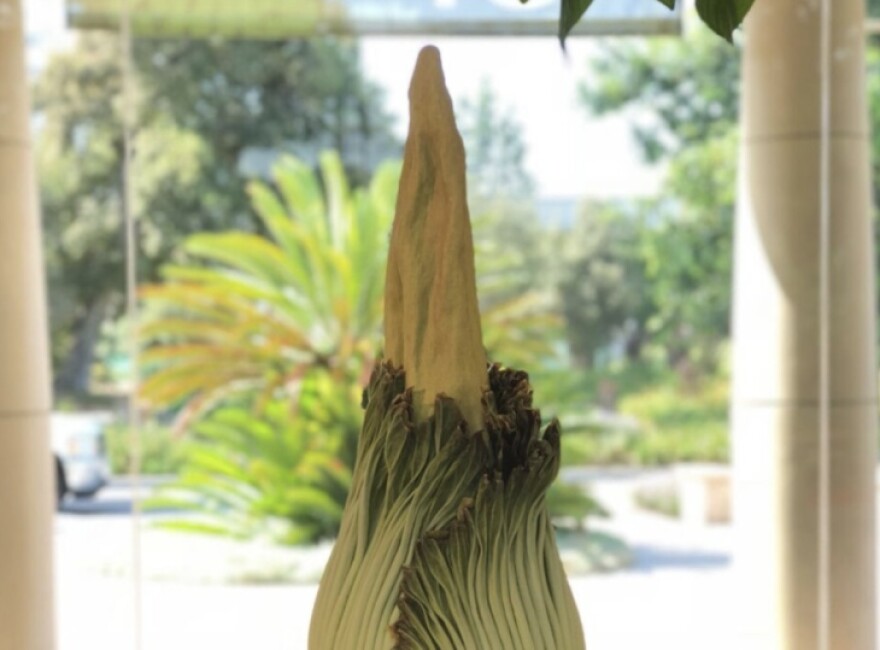With our free press under threat and federal funding for public media gone, your support matters more than ever. Help keep the LAist newsroom strong, become a monthly member or increase your support today.
Li'l Stinker, The Corpse Flower At The Huntington, Won't Be Blooming After All

It looks like Huntington botanical garden's glorious and smelly corpse flower won't be putting assaulting our olfactory neurons after all.
The plant was poised to put on a show this summer, but the botanical team at the Huntington said the corpse flower won't be blooming, according to statements they posted Wednesday on Facebook, Twitter and Instagram. Known as Li'l Stinker, the flower stalk is showing "signs of decay."
"Though it's impossible to say exactly why, here's what we do know--#StinkyPlants have the unique ability of knowing that if they lack the strength to fully bloom, they can stop the process and save their energy for a future bloom," the Huntington wrote on Instagram. "Though Li'l Stinker had showed promising signs of flowering, it appears that it just wasn't ready for the spotlight."
Sad news, flower fans. We've determined that the #CorpseFlower isn't going to bloom. It didn't have enough energy for the job. The Botanical staff will open the inflorescence today to learn more, and we plan to share the process live on Facebook at 11am @ https://t.co/wPsBfolrQT pic.twitter.com/uWDUoKns97
— The Huntington (@TheHuntington) August 8, 2018
The team instead spent Wednesday morning dissecting the plant to learn more about what happened. You can watch the dissection via Facebook Live below.
The Huntington gave an update on the resultsof the dissection on Instagram. The botanical team didn't find a definitive reason for why the bloom didn't happen, but it gathered samples of plant parts to study further. It also collected samples of a "potential mold or fungus found within the plant" to test some more.
Meanwhile, this isn't the end of Li'l Stinker. The corm -- the source of the corpse flower's energy -- remains alive beneath the soil, where it can produce another bloom someday.
This story has been updated.
At LAist, we believe in journalism without censorship and the right of a free press to speak truth to those in power. Our hard-hitting watchdog reporting on local government, climate, and the ongoing housing and homelessness crisis is trustworthy, independent and freely accessible to everyone thanks to the support of readers like you.
But the game has changed: Congress voted to eliminate funding for public media across the country. Here at LAist that means a loss of $1.7 million in our budget every year. We want to assure you that despite growing threats to free press and free speech, LAist will remain a voice you know and trust. Speaking frankly, the amount of reader support we receive will help determine how strong of a newsroom we are going forward to cover the important news in our community.
We’re asking you to stand up for independent reporting that will not be silenced. With more individuals like you supporting this public service, we can continue to provide essential coverage for Southern Californians that you can’t find anywhere else. Become a monthly member today to help sustain this mission.
Thank you for your generous support and belief in the value of independent news.

-
What do stairs have to do with California’s housing crisis? More than you might think, says this Culver City councilmember.
-
Yes, it's controversial, but let me explain.
-
Doctors say administrator directives allow immigration agents to interfere in medical decisions and compromise medical care.
-
The Palisades Fire erupted on Jan. 7 and went on to kill 12 people and destroy more than 6,800 homes and buildings.
-
People moving to Los Angeles are regularly baffled by the region’s refrigerator-less apartments. They’ll soon be a thing of the past.
-
Experts say students shouldn't readily forgo federal aid. But a California-only program may be a good alternative in some cases.







